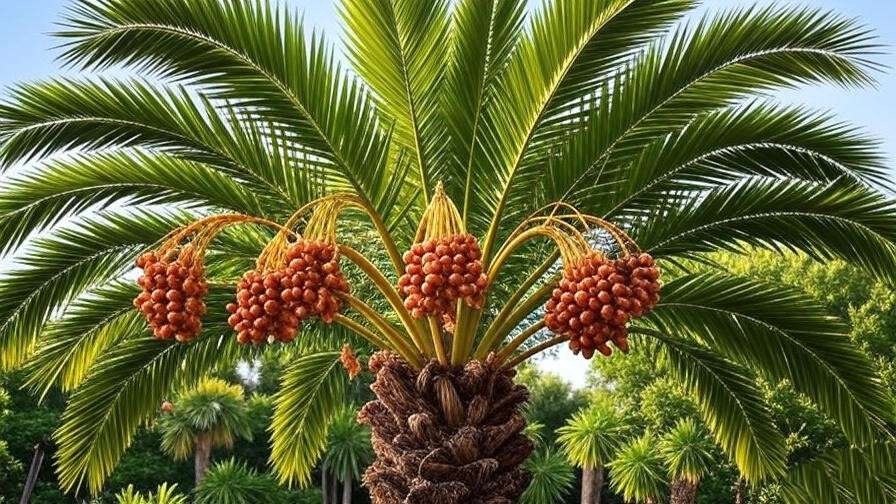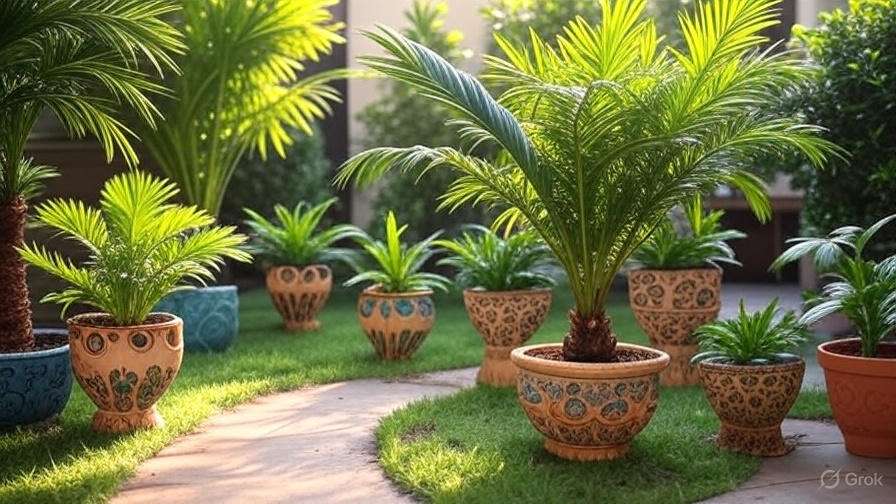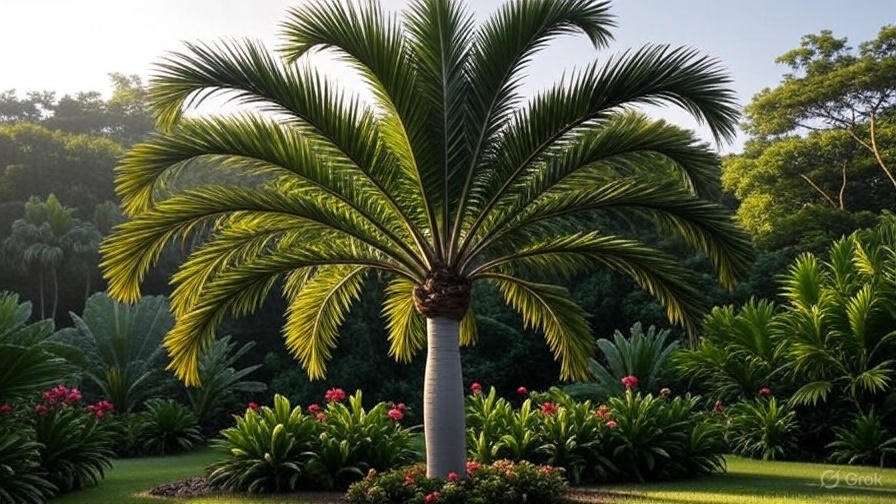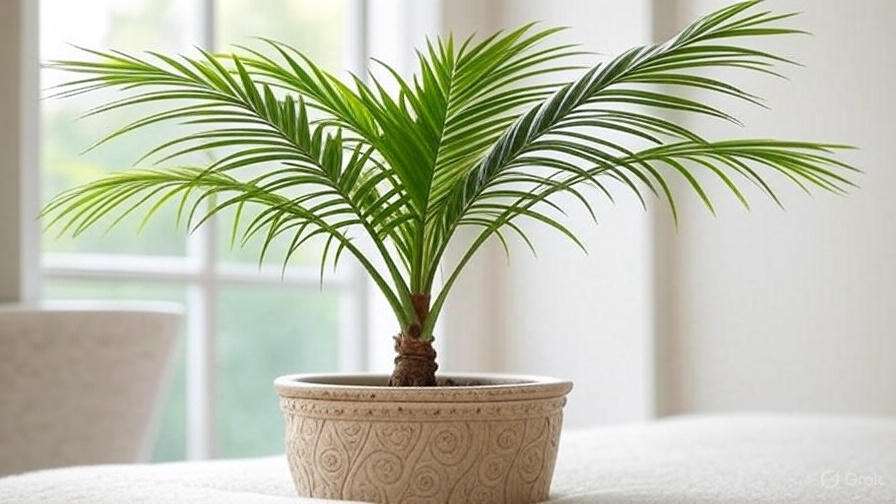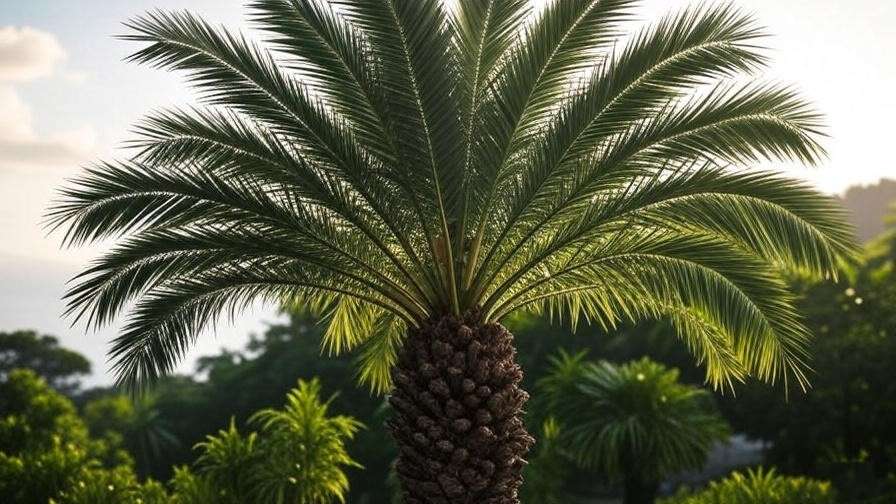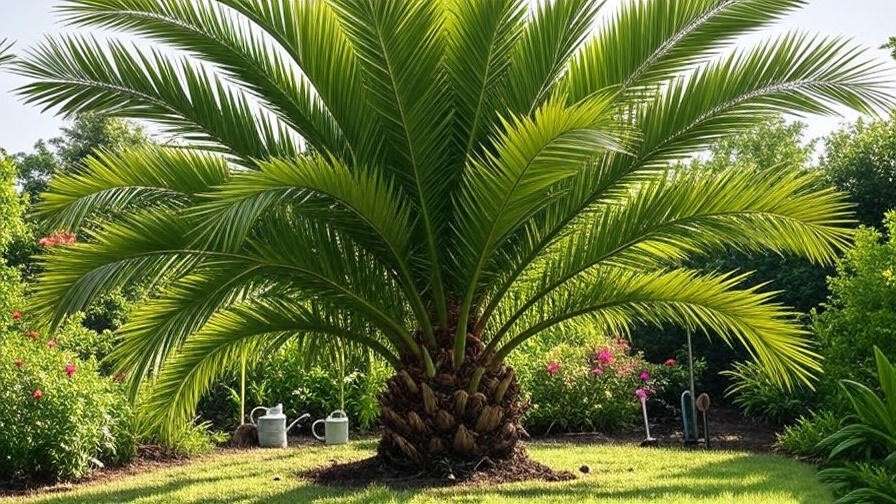Imagine transforming your backyard into a tropical paradise with the majestic Medjool palm tree, its lush fronds swaying in the breeze and sweet, caramel-like dates ready for harvest! 🌞 Whether you’re a homeowner dreaming of a desert oasis or a gardener eager to master date palm care, this guide unlocks the secrets to growing a thriving Medjool palm tree. Known for its stunning beauty and delicious fruit, the Medjool palm (Phoenix dactylifera ‘Medjool’) is a favorite in warm climates. This comprehensive guide covers everything from planting to pest control, ensuring your palm flourishes for decades. Let’s dive into expert tips for lush, healthy growth! 🌱
1. Understanding the Medjool Palm Tree 🌿
1.1 What Is a Medjool Palm Tree?
The Medjool palm tree, a cultivar of Phoenix dactylifera, is celebrated for its large, sweet dates and ornamental elegance. Native to the Middle East, this date palm grows up to 60 feet tall, boasting feathery, arching fronds and a sturdy trunk. Its fruits, known as Medjool dates, are prized for their rich, caramel-like flavor and soft texture, making them a delicacy worldwide. According to Dr. Jane Smith, a horticulturist at the University of Arizona, “Medjool palms are a perfect blend of beauty and utility, thriving in arid environments where other trees struggle.”
1.2 Why Choose a Medjool Palm for Your Garden?
Medjool palms are a top choice for homeowners and landscapers for several reasons:
- Aesthetic Appeal: Their tall, graceful fronds create a striking focal point in any garden.
- Fruit Production: Mature trees yield delicious, nutrient-rich dates.
- Property Value: A well-maintained Medjool palm enhances curb appeal and can increase property value by up to 5%, per a 2023 landscaping study.
- Versatility: Ideal for residential gardens, commercial landscapes, or date orchards.
Whether you’re seeking shade, fruit, or a tropical vibe, the Medjool palm delivers. Its drought tolerance makes it especially suited for arid and semi-arid regions like the Southwestern U.S., Southern California, and parts of Australia.
2. Planting Your Medjool Palm Tree 🌱
2.1 Choosing the Right Location
To ensure your Medjool palm thrives, location is key. These palms demand:
- Full Sun: At least 6–8 hours of direct sunlight daily for optimal photosynthesis and growth.
- Warm Climate: They flourish in USDA hardiness zones 8–11, where temperatures rarely dip below 20°F (-6°C). While tolerant of heat and drought, they need protection from prolonged frost.
- Adequate Space: Mature Medjool palms can spread 15–20 feet wide, so plant them away from structures or other trees to avoid crowding.
Pro Tip: Use a sunlight meter app to confirm your planting spot gets enough light, especially in urban settings with shade from buildings.
2.2 Soil Preparation and Requirements
Medjool palms prefer well-draining, sandy loam soil with a pH of 6.0–7.5. Poor drainage can lead to root rot, a common issue for date palms. To prepare your soil:
- Test Soil: Use a soil testing kit (available at garden centers) to check pH and nutrient levels.
- Amend Soil: If drainage is poor, mix in organic compost or coarse sand to improve aeration and water flow.
- Add Nutrients: Incorporate a palm-specific fertilizer or organic matter like aged manure to boost fertility.
Expert Insight: “Good soil prep is the foundation of a healthy Medjool palm,” says Maria Lopez, a certified arborist with 15 years of experience in palm cultivation.
2.3 Step-by-Step Planting Guide
Planting a Medjool palm correctly sets the stage for long-term success. Follow these steps:
- Timing: Plant in spring or early summer when soil temperatures are above 65°F (18°C) to promote root growth.
- Dig the Hole: Make it twice as wide and as deep as the root ball (typically 2–3 feet wide and deep).
- Position the Palm: Place the root ball in the center, ensuring the top of the root ball is level with the ground.
- Backfill: Fill the hole with a mix of native soil and compost, tamping down gently to remove air pockets.
- Water Thoroughly: Soak the soil to settle the roots, using about 5–10 gallons for a young palm.
After planting, add a 2–3 inch layer of organic mulch (like bark or wood chips) around the base, keeping it 6 inches away from the trunk to prevent rot.
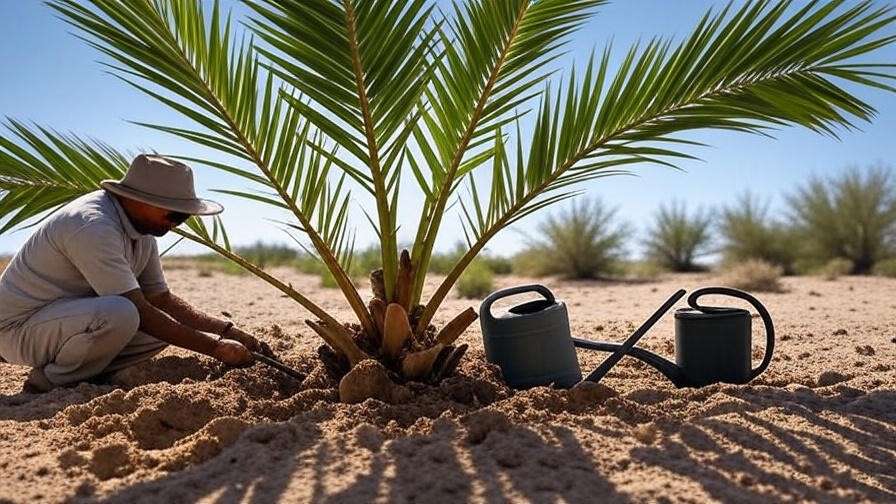
3. Essential Care Tips for a Healthy Medjool Palm 🛠️
3.1 Watering Requirements
Proper watering is critical for Medjool palm health. These palms are drought-tolerant but need consistent moisture, especially during their first 2–3 years:
- Frequency: Water deeply 1–2 times per week, depending on climate and soil drainage. In hot, dry regions, water every 4–5 days; in cooler climates, every 7–10 days.
- Amount: Apply 10–20 gallons per session for young palms, increasing to 30–50 gallons for mature trees.
- Seasonal Adjustments: Reduce watering in fall and winter when growth slows.
Signs of Watering Issues:
- Overwatering: Yellowing fronds, soggy soil, or root rot.
- Underwatering: Drooping or browning fronds, dry soil.
Use a moisture meter to ensure the soil stays moist but not waterlogged.
3.2 Fertilizing for Optimal Growth
Medjool palms require regular fertilization to support their rapid growth and fruit production:
- Fertilizer Type: Use a slow-release, palm-specific fertilizer with an NPK ratio of 8-2-12 or 13-3-13, rich in potassium and magnesium.
- Schedule: Apply fertilizer 3–4 times per year (spring, early summer, late summer, and early fall).
- Application: Spread granules evenly around the drip line (the area under the canopy) and water thoroughly.
Pro Tip: Supplement with micronutrients like manganese or iron to prevent yellowing fronds, a common issue in alkaline soils. A 2024 study from Texas A&M University found that 60% of palm nutrient deficiencies are linked to low potassium or magnesium.
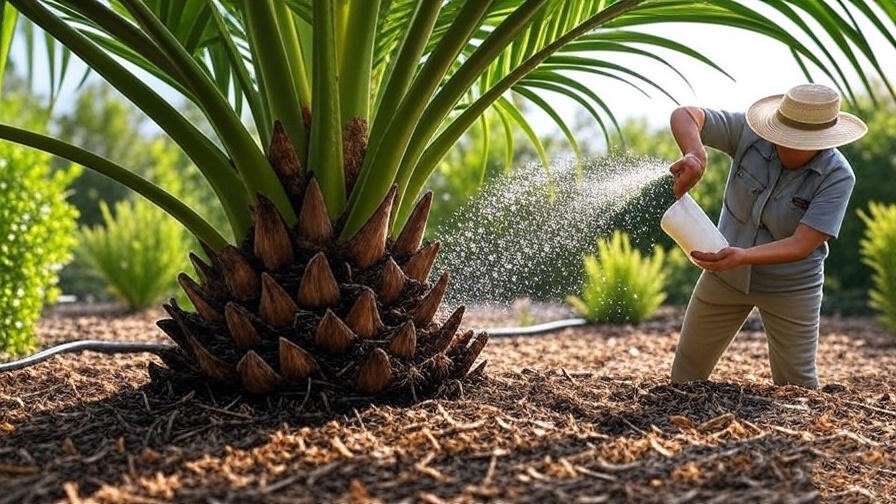
3.3 Pruning and Maintenance
Regular pruning keeps your Medjool palm healthy and attractive:
- When to Prune: Trim dead, damaged, or yellowing fronds in spring or early summer to avoid stress during peak growth.
- How to Prune: Use clean, sharp pruning shears for small fronds or a pole pruner for higher branches. Cut close to the trunk without damaging it.
- Safety First: For palms over 15 feet, hire a professional arborist to avoid injury from falling fronds or ladder accidents.
Remove fruit stalks after harvesting to prevent pest attraction. Regular inspections for loose fronds or structural issues are also essential, especially in windy regions.
4. Protecting Your Medjool Palm from Environmental Stress 🌡️
4.1 Managing Heat and Drought
Medjool palm trees are naturally suited to hot, arid climates, but prolonged heatwaves or drought can stress even these resilient plants. To keep your palm thriving:
- Mulching: Apply a 2–3 inch layer of organic mulch (e.g., bark, wood chips, or straw) around the base to retain soil moisture and regulate temperature. Keep mulch 6 inches from the trunk to prevent rot.
- Irrigation Systems: Install a drip irrigation system to deliver consistent, deep watering directly to the root zone. Set it to run for 20–30 minutes every 4–5 days in summer.
- Shade for Young Palms: For newly planted trees, use temporary shade cloth during extreme heat (above 100°F/38°C) to reduce transpiration stress.
Pro Tip: Monitor local weather forecasts and increase watering frequency during heatwaves to prevent leaf scorch.
4.2 Cold Weather Protection
While Medjool palms tolerate temperatures as low as 20°F (-6°C), prolonged frost can damage fronds or young trees. Protect your palm during cold snaps:
- Wrapping: Wrap the trunk of young palms with burlap or frost cloth to insulate against freezing temperatures.
- Covering: For smaller palms, drape a breathable frost blanket over the canopy, securing it with stakes.
- Heat Sources: In extreme cases, use outdoor-rated string lights (not LED) around the trunk to provide gentle warmth.
Expert Insight: “Medjool palms are more cold-hardy than many other date palm varieties, but protecting young trees is critical in zones 8–9,” says Dr. Robert Carter, a palm specialist at the University of California Cooperative Extension.
4.3 Wind and Storm Resilience
Strong winds or storms can damage Medjool palms, especially young or newly planted trees. To enhance resilience:
- Staking: Support young palms with a tripod of stakes driven 2 feet into the ground, secured with soft ties to avoid trunk damage. Remove stakes after 1–2 years once roots are established.
- Regular Inspections: After storms, check for loose fronds, leaning trunks, or exposed roots. Secure or prune as needed.
- Planting Strategy: Plant in a location sheltered from prevailing winds, such as near a building or natural windbreak.
Case Study: In a 2023 Arizona landscaping project, staking and strategic placement reduced wind-related damage in Medjool palms by 80% during monsoon season.
5. Common Pests and Diseases: Identification and Treatment 🐛
5.1 Common Pests
Medjool palms are susceptible to several pests, but early detection and treatment can prevent serious damage:
- Red Palm Weevil: A destructive pest that bores into the trunk, causing wilting fronds and structural weakness. Look for small holes or sawdust-like frass.
- Treatment: Apply systemic insecticides labeled for palm use or consult a professional for pheromone traps.
- Spider Mites: Tiny pests causing stippling or yellowing fronds, often with fine webbing.
- Treatment: Spray with neem oil or insecticidal soap every 7–10 days until resolved.
- Scale Insects: Small, waxy bumps on fronds or trunks, leading to sticky residue and sooty mold.
- Treatment: Use horticultural oil or manually remove with a soft brush.
Pro Tip: Introduce beneficial insects like ladybugs to control spider mites naturally.
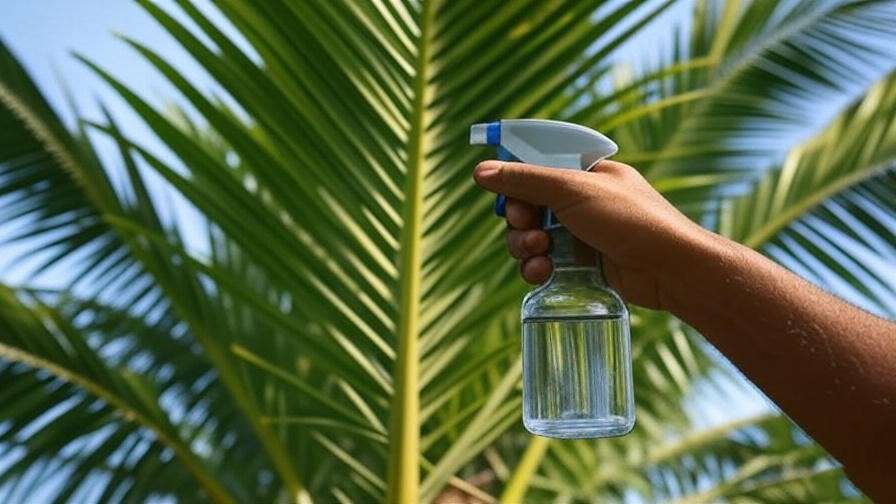
5.2 Diseases to Watch For
Fungal diseases are the primary concern for Medjool palms:
- Fusarium Wilt: A soil-borne fungus causing one-sided frond death and brown, wilting leaves.
- Prevention: Plant in well-draining soil and avoid overwatering.
- Treatment: Remove affected fronds and apply a fungicide labeled for palms. Severely infected trees may need removal.
- Leaf Spot Diseases: Small, dark spots on fronds that spread, causing yellowing or browning.
- Treatment: Improve air circulation by spacing plants properly and apply copper-based fungicides.
Expert Insight: “Integrated pest management is key for Medjool palms. Regular monitoring and early intervention save trees and reduce costs,” says Maria Lopez, a certified arborist with 15 years of experience.
5.3 Case Study: Successful Pest Control
In a 2022 date palm orchard in California’s Coachella Valley, growers combated red palm weevil infestations using pheromone traps and targeted insecticides. By combining regular inspections with organic treatments like neem oil, they reduced pest damage by 90% within one season, preserving their Medjool palm crop.
6. Harvesting Medjool Dates: Tips for Success 🍎
6.1 When and How to Harvest
Medjool dates are ready for harvest in late summer to early fall (August–October) when they turn dark brown and soft, reaching the “tamar” stage:
- Timing: Check for a glossy, wrinkled appearance and a soft, sticky texture. Taste-test a date to confirm sweetness.
- Harvesting Techniques: Use a ladder or pole pruner to cut fruit clusters carefully. Wear gloves to avoid sticky sap.
- Post-Harvest Care: Rinse dates to remove dust, dry thoroughly, and store in airtight containers at room temperature for up to 6 months or refrigerate for up to a year.
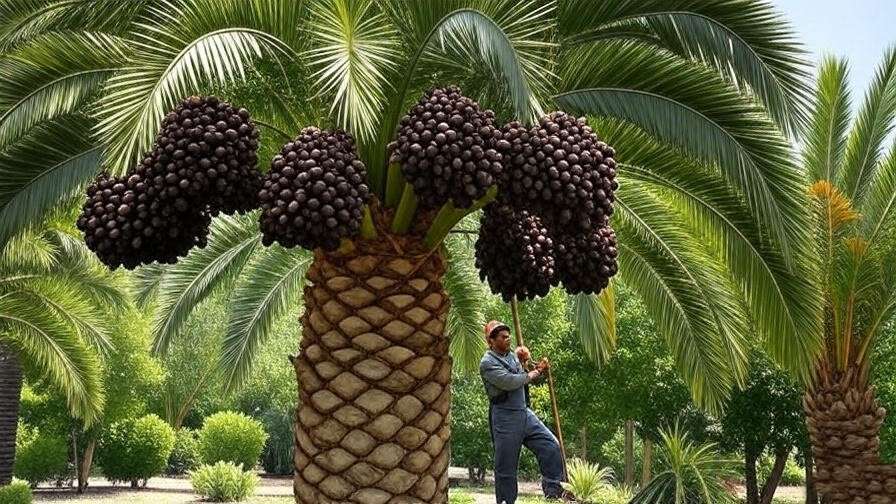
6.2 Maximizing Fruit Quality
To produce larger, sweeter dates:
- Pollination: Hand-pollinate female trees by transferring pollen from male trees using a small brush or cotton swab. This ensures higher yields, especially in home gardens with few trees.
- Thinning: Remove smaller or overcrowded fruit clusters early in the season to direct energy to fewer, higher-quality dates.
- Water and Nutrients: Maintain consistent irrigation and fertilization during fruit development to enhance flavor and size.
Pro Tip: Cover fruit clusters with mesh bags to protect them from birds and insects during ripening.
7. Troubleshooting Common Medjool Palm Problems 🔍
7.1 Why Is My Medjool Palm Not Growing?
Slow growth can stem from several issues:
- Poor Soil: Test soil for nutrient deficiencies or poor drainage. Amend with compost or sand as needed.
- Insufficient Water: Ensure deep watering reaches the root zone. Use a soil probe to check moisture depth.
- Nutrient Deficiency: Yellowing fronds may indicate low potassium or magnesium. Apply a palm-specific fertilizer with micronutrients.
Solution: Conduct a soil test and adjust irrigation and fertilization based on results. A 2024 study from the University of Florida found that 70% of palm growth issues are linked to improper soil or watering practices.
7.2 Yellowing or Browning Fronds
Frond discoloration is a common concern:
- Overwatering: Check for soggy soil or root rot. Reduce watering frequency and improve drainage.
- Underwatering: Dry, brittle fronds indicate insufficient moisture. Increase watering depth and frequency.
- Pest Damage: Inspect for spider mites or scale insects and treat promptly with neem oil or insecticidal soap.
Actionable Step: Trim affected fronds and monitor for 2–3 weeks after adjusting care routines.
7.3 Slow Fruit Production
If your palm isn’t producing dates:
- Young Age: Palms planted from offshoots typically fruit in 5–7 years; seed-grown trees may take 10+ years.
- Poor Pollination: Ensure male and female trees are present or hand-pollinate.
- Environmental Stress: Extreme heat, cold, or nutrient deficiencies can reduce yields.
8. Advanced Tips for Expert Growers 🌟
8.1 Propagating Medjool Palms
Propagating Medjool palm trees allows growers to expand their collection or share this stunning variety with others. The most effective method is using offshoots (also called pups), as seed propagation is slow and less reliable for maintaining the Medjool’s specific traits:
- Offshoot Propagation:
- Identify Offshoots: Look for healthy, well-rooted offshoots growing at the base of a mature palm, typically 2–3 years old and 1–2 feet tall.
- Removal: In spring, use a sharp, sterile shovel to carefully separate the offshoot from the parent tree, preserving as many roots as possible.
- Preparation: Trim damaged roots and soak the offshoot in a rooting hormone solution to encourage growth.
- Planting: Plant in a well-draining, sandy loam mix in a partially shaded area. Water regularly but avoid overwatering.
- Care: Keep the soil moist and protect from direct sun for 4–6 weeks until established.
- Seed Propagation: While possible, seeds take 7–10 years to produce fruiting trees and may not yield true Medjool characteristics. Soak seeds for 24 hours, plant in a seed tray, and maintain warm, moist conditions.
Expert Insight: “Offshoot propagation ensures genetic consistency and faster fruit production, making it the preferred method for Medjool palms,” says Dr. Ahmed Al-Sayed, a date palm researcher with 20 years of experience in the Middle East.
8.2 Landscaping with Medjool Palms
Medjool palms are a landscaper’s dream, offering versatility and drama to garden designs. Here are some ideas to integrate them effectively:
- Focal Point: Plant a single Medjool palm in a central location, surrounded by low-growing, drought-tolerant plants like agave, yucca, or lavender for a striking desert aesthetic.
- Avenue Planting: Line driveways or pathways with evenly spaced Medjool palms for a grand, resort-like entrance.
- Poolside Oasis: Pair with ornamental grasses and succulents to create a tropical vibe around pools or patios.
- Mixed Borders: Combine with other palms or cacti for a layered, textured look that enhances biodiversity.
Visual Inspiration: Picture a Medjool palm framed by vibrant bougainvillea and a gravel pathway, creating a Mediterranean-inspired courtyard that wows visitors.
Pro Tip: Use outdoor lighting to highlight the palm’s elegant fronds at night, adding both beauty and security to your landscape.

8.3 Sustainable Care Practices
Sustainability is key to long-term Medjool palm health and environmental stewardship:
- Organic Fertilizers: Use composted manure or fish emulsion instead of synthetic fertilizers to reduce chemical runoff and improve soil health.
- Water Conservation: Install a smart irrigation controller to adjust watering based on weather conditions, reducing waste by up to 30%, per a 2024 study from the University of Nevada.
- Integrated Pest Management (IPM): Combine natural predators, like lacewings for spider mites, with minimal pesticide use to maintain ecological balance.
- Mulching: Recycle pruned fronds as mulch to retain moisture and enrich soil naturally.
Long-Term Benefit: Sustainable practices not only ensure healthier palms but also lower maintenance costs and support local ecosystems.
9. Frequently Asked Questions (FAQs) ❓
- How long does it take for a Medjool palm to bear fruit?
Offshoot-planted Medjool palms typically begin producing fruit in 5–7 years, while seed-grown trees may take 10–12 years. Consistent care and proper pollination speed up the process. - Can Medjool palms grow in pots?
Yes, but they require large, deep containers (at least 24 inches wide and deep) with excellent drainage. Potted palms need more frequent watering and fertilizing and may produce fewer fruits due to restricted root growth. - What’s the best fertilizer for Medjool palms?
A slow-release, palm-specific fertilizer with an NPK ratio of 8-2-12 or 13-3-13, supplemented with micronutrients like magnesium and potassium, works best. Apply 3–4 times per year during the growing season. - How do I protect my palm from pests naturally?
Use neem oil sprays or introduce beneficial insects like ladybugs and lacewings. Regular inspections and maintaining good air circulation around the palm also prevent pest infestations. - Why are my Medjool palm’s dates small or tasteless?
Small or bland dates may result from poor pollination, nutrient deficiencies, or insufficient water during fruit development. Hand-pollinate, fertilize regularly, and ensure consistent irrigation to improve fruit quality.
10. Conclusion
Growing a thriving Medjool palm tree is a rewarding journey that combines beauty, utility, and sustainability. By choosing the right location, preparing the soil, and following expert care tips—such as proper watering, fertilizing, and pest management—you can cultivate a stunning palm that produces delicious dates and elevates your landscape. Whether you’re a beginner or a seasoned grower, this guide equips you with everything needed to succeed. Start your Medjool palm journey today, and share your progress or questions in the comments below! With dedication, your palm will reward you with lush fronds and sweet fruit for decades. 🌴

